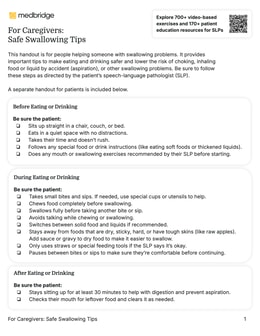Safe Swallowing Strategies Handout PDF for Speech-Language Pathologists
For SLPs, managing dysphagia means guiding patients to prevent aspiration. Access tips and a free handout for safer swallowing practices.
February 4, 2025
10 min. read

Aspiration occurs when food, liquid, or saliva mistakenly enters the airway instead of the esophagus, potentially leading to pneumonia, dehydration, or malnutrition. Following aspiration precautions is an important step in helping patients with swallowing difficulties avoid serious health complications.
To help speech-language pathologists educate patients and caregivers, we’ve created a free, printable safe swallowing strategies handout PDF, including both caregiver and patient versions.
This resource outlines practical tips for safe eating and drinking. The caregiver version provides step-by-step instructions on assisting individuals with swallowing difficulties, including positioning, meal preparation, and recognizing signs of aspiration. The patient version is a simplified format designed for those with cognitive or language impairments, presenting key swallowing precautions in clear, easy-to-follow language. Both versions ensure that swallowing precautions are accessible and easy to understand, empowering patients and caregivers alike.
In this article, we will explore the importance of aspiration precautions, identify who is most at risk, and discuss how SLPs can apply these strategies effectively in their practice. You can also download the free safe swallowing strategies handout PDF below to integrate into your practice and share with patients, families, and caregivers.
Safe Swallowing Strategies Handout PDF
Fill out the form to unlock your free Safe Swallowing Strategies Handout PDF!

Understanding aspiration risks and precautions
What is aspiration?
Aspiration occurs when food, liquids, or saliva enter the airway instead of traveling down the esophagus to the stomach during swallowing. This is particularly concerning for patients with dysphagia—a condition causing impaired swallowing. As a result, material may be more likely to enter the airway, increasing the risk of complications. For a visual explanation, watch the video below about how aspiration occurs during swallowing.
If left unmanaged, aspiration can lead to severe health issues, such as aspiration pneumonia, a respiratory infection caused by bacteria-laden material in the lungs. Frequent incidents may also result in malnutrition, dehydration, and chronic respiratory problems, which can significantly impact a patient’s quality of life.
While minor aspiration episodes may be cleared by a strong cough reflex, frequent or severe episodes can overwhelm pulmonary defenses, causing chronic inflammation, infection, and long-term damage to lung health. Understanding how aspiration occurs and its consequences is critical for identifying at-risk patients and developing targeted interventions to improve swallowing safety and overall health outcomes.
What are the common signs of aspiration?
Recognizing the signs of aspiration helps you to identify swallowing issues early and implement strategies to reduce risks. By staying vigilant about these indicators, you can take timely action to address complications and support better outcomes for your patients.
Coughing or choking during meals: Often the most immediate and visible sign, this reaction may indicate that food or liquid has entered the airway, triggering the body’s natural protective mechanisms.
Wet or “gurgly” voice quality after swallowing: This can suggest that material is lingering in the airway or vocal cords, creating an audible change in voice quality.
Shortness of breath or breathing changes: Difficulty breathing during or shortly after eating may signal airway obstruction or reduced clearance of aspirated material.
Recurrent respiratory infections or pneumonia: Frequent chest infections, particularly aspiration pneumonia, often result from bacteria introduced into the lungs by aspirated material.
Identifying these signs allows for immediate adjustments to swallowing strategies and establishes a foundation for long-term management. Promptly addressing these symptoms helps uncover the underlying causes of aspiration, supports patients through rehabilitation, and encourages adherence to critical precautions that safeguard their health.
Who is at risk?
Some patient groups are more vulnerable to aspiration due to medical conditions or physical impairments. Identifying these populations and addressing their specific challenges is necessary for minimizing aspiration risks and improving swallowing safety.
Stroke survivors: Dysphagia affects more than 50 percent of people who have had a stroke,1 often due to damage in the brain areas responsible for swallowing strength, sensation, and coordination. As a result, these individuals face a higher risk of aspiration pneumonia because they struggle with airway protection. Targeted interventions for managing dysphagia may include exercises to strengthen the tongue and Shaker exercises, which help improve the opening of the upper esophageal sphincter.
Older adults: As individuals age, muscle weakening and delayed reflexes can hinder their ability to protect the airway while swallowing. Cognitive impairments, such as dementia, worsen these difficulties. Studies estimate that the prevalence of dysphagia in individuals with dementia ranges from 13 to 57 percent,2 emphasizing the importance of careful monitoring and customized interventions for this population.
Patients with neurological conditions: Neurological disorders like Parkinson’s disease, amyotrophic lateral sclerosis (ALS), and multiple sclerosis (MS) disrupt the coordination and strength needed for effective swallowing. Dysphagia affects 10 to 33 percent of older adults, with prevalence particularly high among those with neurodegenerative diseases.3 For these patients, strategies such as the Mendelsohn maneuver (to improve laryngeal elevation and coordination) and chin-tuck posture adjustments can reduce aspiration risk.
Individuals undergoing head or neck cancer treatment: Radiation, surgery, and chemotherapy can damage or weaken the muscles involved in swallowing. Scar tissue and pain often add to the difficulty, reducing airway protection. To address these challenges and support safe swallowing, you must implement tailored precautions, such as using modified food textures, practicing specific swallowing techniques, and incorporating exercises to stretch and strengthen the affected muscles.
Understanding what aspiration is, its common signs, and which patient groups are most at risk provides a strong foundation for managing swallowing safety. This knowledge equips you to identify concerns early, tailor interventions effectively, and educate patients and caregivers about the importance of prevention. The printable safe swallowing strategies handout PDF builds on this understanding, offering a practical resource to reinforce these strategies and empower patients to follow safe swallowing practices at home.
Key safe swallowing strategies for patients
The safe swallowing strategies handout PDF provides clear, actionable guidelines to help reduce the risk of aspiration and improve swallowing safety. Below are practical tips derived from these guidelines that can help address common challenges and reduce complications:
Sit upright during and after meals: Encourage patients to maintain a 90-degree posture while eating and stay upright for at least 30 minutes afterward, to help prevent food or liquid from entering the airway.
Take small bites and sips: Eating slowly and carefully ensures better control of food and liquid intake. Patients prescribed thickened liquids should maintain the recommended consistency to slow the liquid flow, allowing more time for airway closure.
Limit distractions during meals: A calm, focused eating environment helps patients concentrate on swallowing and reduces the risk of accidental aspiration. This is especially important for individuals with cognitive impairments or neurological conditions, as they may be more prone to unintentional swallowing difficulties.
Practice good oral hygiene: Proper oral care before and after meals helps remove food particles and bacteria, reducing the risk of infection if aspiration occurs.
Follow specific dietary recommendations: Patients may need to avoid certain foods (e.g., dry, sticky, or tough-textured foods) or follow a modified diet based on recommendations from their speech-language pathologist.
Pause between bites and sips: Slowing down allows for safer swallowing and reduces the likelihood of food or liquid entering the airway.
By following these strategies daily, patients can lower their aspiration risk and improve overall swallowing safety. The safe swallowing strategies handout PDF reinforces these practices with an easy-to-follow guide that empowers both patients and caregivers.
Using the handout in clinical practice
The safe swallowing strategies handout PDF is a valuable tool for reinforcing safe swallowing habits beyond therapy sessions. Incorporating this resource into patient care can enhance education, improve adherence to swallowing precautions, and support patients and caregivers more effectively.
Patient consultations
The handout serves as a practical reference during consultations, helping you explain aspiration precautions and safe swallowing strategies in a clear, structured manner. Patients often retain information better when receiving verbal explanations and written guidelines, reinforcing key concepts.
Use the safe swallowing strategies handout PDF to demonstrate specific techniques, such as proper posture during meals or taking small sips and bites, ensuring patients feel confident applying these strategies.
Take-home resource
Providing a printed copy of the handout allows patients and caregivers to revisit essential guidelines between sessions. Having a written reference reinforces key precautions and encourages adherence at home. It also serves as a helpful reminder for patients to follow recommended strategies consistently, especially when not in a clinical setting.
Family and caregiver training
Caregivers play a critical role in supporting patients with swallowing challenges. During training sessions, use the safe swallowing strategies handout PDF to educate families on their role in maintaining aspiration precautions. This ensures they feel prepared to assist with meal pacing, posture, and supervision.
By integrating this resource into your practice, you can empower patients and caregivers with the knowledge and strategies needed to reduce aspiration risks and improve swallowing safety.
Expanding your toolbox for speech-language pathology success
If you are a speech-language pathologist working with patients across various areas of need, you understand that access to reliable, evidence-based tools can make all the difference. Whether you're addressing swallowing challenges, communication disorders, or other speech pathology topics, these resources provide opportunities to enhance your clinical skills and deliver more effective, patient-centered care.
On-demand courses: Continuing education is essential for you to stay current and expand your expertise. Accessing courses focused on key SLP topics—such as clinical assessment of swallowing, dysphagia management, and communication disorders—allows you to deepen your understanding and refine your clinical skills. Flexible learning options make it easier to grow professionally at your own pace, fitting education into your busy schedule.
Webinars: Live webinars designed for speech-language pathologists provide opportunities to stay informed on various topics relevant to your practice. Led by industry experts, these interactive sessions tackle real-world challenges, offering actionable insights and downloadable materials to support your continued professional development.
Podcasts: Listening to podcasts offers a convenient and engaging way to sharpen your clinical skills while gaining valuable insights, practical tips, and fresh inspiration to tackle the complexities of patient care. For a deeper dive into the challenges you face daily, tune into Speech Scope, where subject matter experts break down complex clinical topics and explore relevant case studies.
Patient education tools: Provide your patients and caregivers with clear, accessible resources like handouts and videos to support their understanding of speech and swallowing safety practices. These materials complement your clinical guidance, boosting patients' confidence in managing their conditions and equipping caregivers with practical knowledge.
Incorporating these tools alongside the printable safe swallowing strategies handout PDF creates a comprehensive approach to patient care. Combining expert education with practical resources can empower your patients to take charge of their swallowing health while ensuring caregivers feel prepared to provide effective support.
Taking the next step in patient care
Aspiration precautions are an essential aspect of care for patients with swallowing difficulties. By following simple yet effective strategies—such as sitting upright during meals, maintaining good oral hygiene, and eating slowly—patients can significantly lower their risk of complications. To support your practice, download the free safe swallowing strategies handout PDF today, which includes both a caregiver guide and a simplified patient version to support different health literacy needs and promote safer swallowing for all.
References
González-Fernández, M., Ottenstein, L., Atanelov, L., & Christian, A. B. (2013). Dysphagia after Stroke: an Overview. Current physical medicine and rehabilitation reports, 1(3), 187–196. https://doi.org/10.1007/s40141-013-0017-y
Alagiakrishnan, K., Bhanji, R. A., & Kurian, M. (2013). Evaluation and management of oropharyngeal dysphagia in different types of dementia: a systematic review. Archives of gerontology and geriatrics, 56(1), 1–9. https://doi.org/10.1016/j.archger.2012.04.011
Thiyagalingam, S., Kulinski, A. E., Thorsteinsdottir, B., Shindelar, K. L., & Takahashi, P. Y. (2021). Dysphagia in Older Adults. Mayo Clinic proceedings, 96(2), 488–497. https://doi.org/10.1016/j.mayocp.2020.08.001





